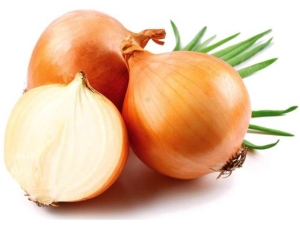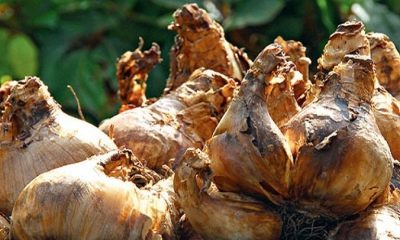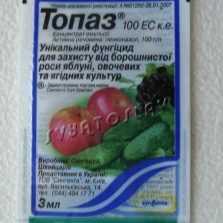Methods to combat diseases and pests onions

It is believed that onions are unpretentious in the care and gardeners have no problems with its cultivation. Onion infusion helps to prevent fungal diseases, as well as it is often used to scare off pests. At the same time, the plant itself is often subject to various diseases and insect attacks.
Typical diseases
Diseases are able to hit onions both in the process of growing and during its storage.
- Mealy dew - This is a fungal disease, especially often affecting many horticultural crops. It is transmitted most often through seeds. With untimely measures taken, the harvest can suffer greatly. Moreover, the factors that contribute to infection, may not depend on the person - this is the shade of the planted area, heavy rainfall, improper watering of plants. The symptoms of powdery mildew can be seen already in late April - early May, these include yellow-green spots on the plant, gradually becoming gray-purple with a white patina, looking like flour. Over time, the plaque darkens and becomes denser, the greens nick, and the bulbs stop growing. Experts brought varieties that are less affected by the fungus. This, for example, "Antey", "Centurion", "Stimulus" and "Iris".
- Perinosporosis - A disease that is also called downy mildew. Yellow spots that appear on the bow, over time, become lilac, the green fades and dries out. Coolness, shade and rain are especially conducive to the development of this disease. The bulbs in the process begin to rot. With dry summer and high air temperatures, the fungus does not have the ability to develop, but its spores are able to remain in the soil until next year.
Varieties that do not suffer from this scourge, does not exist, but varieties such as "Ellan", "Christina", "Stuttgarter Life" infect less.
- Rust. Symptoms of this disease are visible only on the feathers of the bow. At first, specks of reddish color and bright yellow with small fibers appear. Then they become denser and change color to terracotta and rust, after which they turn black. Most often, the fungus is transmitted through the soil.
- Aspargillosis (black rot) - the disease manifests itself during the storage of onions. The reason is its poor drying and immaturity. In order for the disease to develop rapidly, it is enough to break the rules of storage and place the onions in a hot unventilated room. The bulbs themselves become soft after infection, their neck loses color, the tip dries. Between the scales appears plaque, reminiscent of black powder. This is the spores of the fungus.
- Gray neck rot also manifested during storage. The first symptoms are visible in just a couple of weeks. First, the neck dries out, and the area under it is covered with a gray bloom with black small dots, which gradually captures a larger area. If you cut the onion, it will have a pinkish tint. The fungus is entered when the surface is mechanically damaged, for example, when the green is cut.
- Fusarium it is manifested by yellowing of feathers, stopping the growth of bulbs, the neck of which is covered with a light patina like mold, the smell of rot spreads. It develops well in hot and dry weather and can affect even harvested crops. Black dots appear inside the bulbs; they completely dry out.
- Mosaic - This is a virus that is characterized by slower growth of onions, deformation of flowers and a mosaic light pattern on the leaves. The bulbs become elongated, while you can eat them.
- Jaundice - A virus that is also not treated. The bulbs do not grow, the feathers turn yellow from the ends.
Parasites
There are pests that are very fond of this culture and bring a lot of problems to gardeners. We give a description of the most common.
- Onion fly - This is a harmful insect that especially loves onions grown from seeds, as it grows thicker, which means that the larvae move easier.If the plant was affected by rot or nematode, it becomes especially easy prey. Greens gradually begin to fade, starting from the base. After that, the larvae penetrate through the neck into the bulb, starting the process of its rotting.
The end of April - the beginning of May - this is the most dangerous period. As soon as the bird cherry and lilac bloom, the insects begin to multiply, leaving the larvae in the soil or in the onion itself.
- Shallot Aphid attacks the onion en masse and sucks its juice. Greens are deformed and twisted by a tube, on which bright spots appear, yellowing over time. Aphid has a dark color, after its attack the bow is covered with black bloom, which is nothing but a fungus and skins of the larvae.
- Tobacco thrips prefers tobacco, but he can also do a lot of damage to the bow. After his attack, the leaves lighten and dry, the bulbs stop growing and their scales dry out. Most of these insects are at the base of the green where there are dying feathers.
- Onion Keeper it has a small size, greenish-bronze outflow and a long proboscis, for which it is called the weevil. It is with a nose that he sucks onion juice, and the larvae eat greens from the inside. Bright spots appear on the green, which, drying out, lead to the death of the whole plant. The pest attacks only onions, which grow from seeds, and do not like the process of loosening the soil.
- Onion moth is a brown shade butterfly. Larvae-caterpillars are yellowish-green, have a small bristle, and they harm plants. The larvae penetrate into the leaves and devour them, outside the passages look like tunnels. Also, the insect does not disdain the bulb itself.
- Onion mite - arachnid insect, almost imperceptible by visual inspection due to the fact that it has an almost transparent body. Also, the pest gladly feeds on potatoes, beets, carrots and some types of flowers, for example, tulips and gladioli. The tick loves high temperatures and dry weather, and eats plant leaf juice as food. After his attack on the greens, specks of yellow color and light patina appear, eventually leading to drying of the plant.
This bug is unsafe for a bow that has already been removed. It penetrates it through the Donets and devours it from the inside, which leads to the processes of decay and drying.
- Stem Nematode - A parasite that can attack both onions and garlic. It has microscopic size and shape of a worm. The pest penetrates the onion through the roots and gradually moves up, poisoning it with its waste. Since several thousands of worms can fall on one bulb, the plant dies quite quickly. At first the leaves change their shape, then sag, the bulb becomes softer and cracks appear on it. When precipitation falls, the smell of rot becomes noticeable. Onions have swollen and grainy scales.
- Onion hover, or kornekaas gardeners call it, it visually very much resembles an onion fly, but it has larger sizes. Attacks the harvest from late June to early July, eating away from the inside of the bulb. The plant rots and dies.
What can be processed?
Every gardener hopes for a good and healthy harvest. To get one, you need to take certain measures of protection. In a situation with bulb onions it is possible to use both shop preparations, and national methods.
Effective drugs
Drugs that can help with various diseases and pest control may be different in each case. However, there are those who are able to cope with several problems at the same time.
For powdery mildew, peronosporosis and a number of other diseases, it is necessary to treat both onions and the beds themselves. For the treatment used solutions "Topaz", "Scor", "Polycarbacin". Copper sulfate and Bordeaux liquid will also work, but with one limitation - if green onions are not grown.After using these drugs is possible blue tint on the green, it is absolutely normal. Spray the plants should be every 1-2 weeks, you need to repeat the procedure 2-3 times. For a longer and more effective exposure, soap can be added to the solutions. It can be both liquid and economic, grated, which will also improve the adhesion of the compositions.
Such drugs as Thanos, Ridomil-Gold and Abiga-Peak help well with peronosporosis. If rust has appeared on the greenery, you should apply “Captan” or “Zineb”.
If pests appeared on the garden, it can be quite problematic to get rid of them. Even if you water the entire garden with toxic chemicals, there is no guarantee of a successful outcome.
From onion flies and hoverflies, “Bazudin” and “Fufanon” help well, besides, they also destroy the larvae under the condition of double processing. Scoop and moths are afraid of the drug "Iskra M", the secretive trunk - "Karbofoksa." Also effective among gardeners are such tools as "Aktara", "Karate" and "Inta-Vir".
It should be borne in mind that small insects, such as aphids and mites, can withstand the effects of chemical agents. The solution of colloidal sulfur works well on them. Shalotova aphid is afraid of universal insecticides. In the fight against it, you can use "Intra-Vir", "Tanrek", "Mospilan". Entobacterin and Lepidocid are suitable for fighting with onion moths.
Onion mites are not insects, so you should not use universal insecticides to get rid of them. Moreover, the treatment should be carried out up to 4 times and in its process to change drugs, otherwise the pest will have immunity and the fight against it will be ineffective. Acaricides such as Neoron, Apollo, Binom and Vertimec help well.
Folk remedies
Due to the fact that onions are often attacked by pests, gardeners have adapted to use folk remedies to preserve the harvest.
In the fight against flies, an infusion, in which black ground pepper or tobacco is added, helps well. Their larvae are able to destroy saline. It should be applied directly under the root. It is also useful to powder the area where the onions grow, with tobacco dust, ash and red pepper, while the ingredients need to be mixed in equal amounts.
In order for the onion fly not to choose the beds with onions, you need to plant carrots next to them. This excellent neighborhood is also due to the fact that onions scare away carrot agony. A solution of ammonia also repels pests well, it is enough to dissolve 3 spoons of the product in 10 liters of water, and pour the planting with this compound.
However, you need to act carefully so that the liquid does not hit the greens, and after 7 days, the procedure should be repeated. Ammonia can be used in the same way. The effect is similar, but after processing, they need to pour the plants with still clean water.
Saline solution is convenient because it does not have a sharp unpleasant odor. For its preparation is required to dissolve 300 grams of salt in 10 liters of liquid. In addition, the composition does not harm in contact with the earth and greens. At the same time, it is possible to carry out 3 treatments as much as possible, and the pause between them should be 9-10 days, since more watering can cause salinization of the soil.
Preventive measures
So that diseases and pests do not spoil the crop, you need to think about prevention, which will protect future plantings. First of all, it is recommended to treat the seeds and onions before planting. To do this, they should be placed for 6-8 hours in hot water, the temperature of which is approximately 40 degrees. A solution of potassium permanganate is also suitable. After the procedure, the heads and seeds should be dipped into one of such compositions as “Baktofit”, “Fitolavin” or “Poliram” and kept there for about 20 minutes.
After the harvest is collected, all plant debris needs to be removed, and the bed to dig.Crop rotation plays a very important role, since planting onions in the same place for more than 4 years in a row will adversely affect its yield. An onion bed should not be made in places where parsley, garlic, toffee or beetroot grew.
When loosening the beds, you can add crushed chalk or wood ash. Potassium permanganate will also give strength to onions, with a weak solution of which it is recommended to water the plants every 2 weeks. Also, gardeners recommend using diluted whey or sour kefir, which should be added a few drops of iodine. In autumn, the beds are treated with a solution of “Oxyhoma” or “Horus”.
When detecting the first signs of disease, it is necessary to minimize watering as much as possible, and stop adding feedings containing nitrogen and organic matter.
For the prevention of black rot, it is useful to process the onion and flower bed with a one-percent solution of Bordeaux mixture, but this should be done approximately 3 weeks before the crop is planned to be removed. Slaked lime should be used when disinfecting the storage area. Powder bulbs with ash or chalk also does not hurt.
For the prevention of gray rot, the onions need to be dried for 10 days in a warm and well-ventilated room. Keep it at a humidity of about 70 percent and a temperature slightly above 0 degrees. A week before harvesting, the plants are treated with the “Switch” or “Quadris” solution. To eliminate the appearance of Fusarium, before planting the bulbs are kept in the "Fundazole" or "Quadris". Once every 10-12 days you need to water the beds with solutions of biofungicides.
Viral diseases can be transmitted from diseased plants to healthy ones, and insects contribute to their spread, so pest control can also protect against other problems. So that insects do not attack the landings, it is necessary to cultivate the earth with a mixture of tobacco dust, ground pepper and ash. The procedure is carried out 10-15 days after the onion is planted in the garden. Also, when loosening the soil in spring, it will be possible to add granules of such preparations as “Zemlin”, “Muhoed” and “Medvetoks” to it. It is useful to sprinkle with ammonia and vinegar.
Aphids are afraid of the smells of marigold, mint, calendula and coriander, so these plants can be planted next to the onion. Spraying with hot pepper, ash, or colloidal sulfur will also help. These infusions help not only to scare away insects, but also to fight with those who have already chosen the garden bed to live in, but for this purpose it is necessary to carry out spraying every day.
Batun has juicy green leaves, so it can be used as bait. When insects stick around greenery, it is cut off and destroyed along with pests.
An excellent preventive measure for the healthy growth of onions is proper watering, weeding, and crop rotation.
The soil should be prepared for planting, disinfecting measures should be carried out, and only healthy seeds and heads should be used for sowing.
On the disease of onions and methods of control, see the following video.




















































